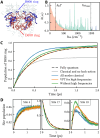Nuclear quantum effects slow down the energy transfer in biological light-harvesting complexes
- PMID: 40479072
- PMCID: PMC12143380
- DOI: 10.1126/sciadv.adw4798
Nuclear quantum effects slow down the energy transfer in biological light-harvesting complexes
Abstract
We assess how quantum-mechanical effects associated with high-frequency chromophore vibrations influence excitation energy transfer in biological light-harvesting complexes. After defining a classical nuclear limit that is consistent with the quantum-classical equilibrium, we include nuclear quantum effects through a variational polaron transformation of the high-frequency vibrational modes. This approach is validated by comparison with fully quantum-mechanical benchmark calculations and applied to three prototypical light-harvesting complexes. For light-harvesting complex 2 of purple bacteria, the inter-ring transfer is 1.5 times slower in the quantum treatment than in the classical treatment. For the Fenna-Matthews-Olson complex, the transfer rate is the same in both cases, whereas for light-harvesting complex II of spinach, the transfer is 1.7 times slower in the quantum treatment. The effect is most pronounced for systems with large excitonic energy gaps and strong vibronic coupling to high-frequency modes. In all cases, nuclear quantum effects are found to be unimportant for the directionality of energy transfer.
Figures



Similar articles
-
Identification and design principles of far-red-absorbing chlorophyll in the light-harvesting complex.J Biol Chem. 2025 Jun;301(6):108518. doi: 10.1016/j.jbc.2025.108518. Epub 2025 Apr 18. J Biol Chem. 2025. PMID: 40254256 Free PMC article.
-
Antidepressants for pain management in adults with chronic pain: a network meta-analysis.Health Technol Assess. 2024 Oct;28(62):1-155. doi: 10.3310/MKRT2948. Health Technol Assess. 2024. PMID: 39367772 Free PMC article.
-
Active body surface warming systems for preventing complications caused by inadvertent perioperative hypothermia in adults.Cochrane Database Syst Rev. 2016 Apr 21;4(4):CD009016. doi: 10.1002/14651858.CD009016.pub2. Cochrane Database Syst Rev. 2016. PMID: 27098439 Free PMC article.
-
Interventions for promoting habitual exercise in people living with and beyond cancer.Cochrane Database Syst Rev. 2018 Sep 19;9(9):CD010192. doi: 10.1002/14651858.CD010192.pub3. Cochrane Database Syst Rev. 2018. PMID: 30229557 Free PMC article.
-
Signs and symptoms to determine if a patient presenting in primary care or hospital outpatient settings has COVID-19.Cochrane Database Syst Rev. 2022 May 20;5(5):CD013665. doi: 10.1002/14651858.CD013665.pub3. Cochrane Database Syst Rev. 2022. PMID: 35593186 Free PMC article.
References
-
- Lambert N., Chen Y.-N., Cheng Y.-C., Li C.-M., Chen G.-Y., Nori F., Quantum biology. Nat. Phys. 9, 10–18 (2013).
-
- Higgins J. S., Lloyd L. T., Sohail S. H., Allodi M. A., Otto J. P., Saer R. G., Wood R. E., Massey S. C., Ting P.-C., Blankenship R. E., Engel G. S., Photosynthesis tunes quantum-mechanical mixing of electronic and vibrational states to steer exciton energy transfer. Proc. Natl. Acad. Sci. U.S.A. 118, e2018240118 (2021). - PMC - PubMed
-
- Kim Y., Bertagna F., D’Souza E. M., Heyes D. J., Johannissen L. O., Nery E. T., Pantelias A., Sanchez-Pedreño Jimenez A., Slocombe L., Spencer M. G., Al-Khalili J., Engel G. S., Hay S., Hingley-Wilson S. M., Jeevaratnam K., Jones A. R., Kattnig D. R., Lewis R., Sacchi M., Scrutton N. S., Silva S. R. P., McFadden J., Quantum biology: An update and perspective. Quantum Rep. 3, 80–126 (2021).
-
- Engel G. S., Calhoun T. R., Read E. L., Ahn T.-K., Mančal T., Cheng Y.-C., Blankenship R. E., Fleming G. R., Evidence for wavelike energy transfer through quantum coherence in photosynthetic systems. Nature 446, 782–786 (2007). - PubMed
-
- Cao J., Cogdell R. J., Coker D. F., Duan H.-G., Hauer J., Kleinekathöfer U., Jansen T. L. C., Mančal T., Miller R. J. D., Ogilvie J. P., Prokhorenko V. I., Renger T., Tan H.-S., Tempelaar R., Thorwart M., Thyrhaug E., Westenhoff S., Zigmantas D., Quantum biology revisited. Sci. Adv. 6, eaaz4888 (2020). - PMC - PubMed
MeSH terms
Substances
LinkOut - more resources
Full Text Sources

